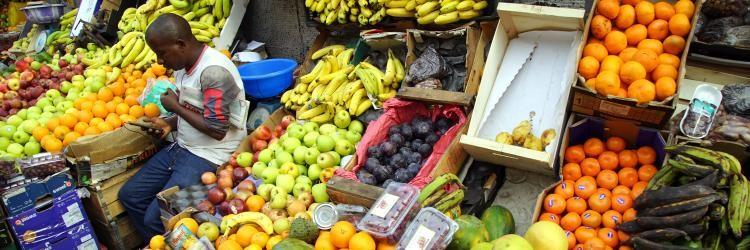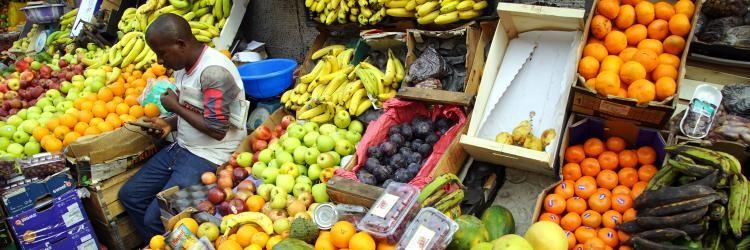
In order to tackle climate change (and a bunch of other wicked challenges), sustainable development has been put high on the global agenda in recent years – with the Sustainable Development Goals (SDGs) agenda obviously being the most prominent example. SDG 12, sustainable food production and consumption, is one of the core sustainable development domains of interest. Along these lines, in January 2019, a new planet-friendly diet coined the ‘planetary health diet’, was launched. The diet is “a global reference diet for adults that is symbolically represented by half a plate of fruits, vegetables and nuts. The other half consists primarily of whole grains, plant proteins (beans, lentils, pulses), unsaturated plant oils, modest amounts of meat and dairy, and some added sugars and starchy vegetables.” Because of its diversity, the planetary health diet is flexible – it can easily be adapted to personal & cultural nutritional needs and tastes. At the same time, it helps to cut down on the intake of red meat and saturated fat. The latter is supported by the UN Intergovernmental Panel on Climate Change’s (IPCC) Special Report on Climate Change and Land (aka “the Special Report on climate change, desertification, land degradation, sustainable land management, food security, and greenhouse gas fluxes in terrestrial ecosystems”), which highlighted the need to cut meat production (and thus consumption). A recent letter in the Lancet Planetary Health went in the same direction, calling for ‘renewed Paris pledges to transform agriculture’, among others because the livestock sector largely displaces natural carbon sinks.
In spite of all this, the planetary health diet is still largely considered a “northern construction” and remains unpopular in Africa. This is despite the fact that the continent is grappling with several challenges (including climate change and chronic health conditions ) which this diet seeks to address. It is evident that a largely plant-based diet has several medium- and long-term advantages, which are even more important in Africa, particularly in the light of the demographic pressure on the continent. The question however is, how can we facilitate the transition towards this diet in Africa?
Over time, food production in sub-Saharan Africa (SSA) has increased in line with the population, with the increase in meat production being twice as high as for plant-based food production. However, meat production in most parts of sub-Saharan Africa, especially East and West Africa still relies on rudimentary pastoral methods inherited from past generations. The pastoral methods (in combination with the rising population) can jeopardize the quantity of grassland and hence the rate at which carbon emissions are removed from the environment. Therefore, meat production in SSA is already a great climate change risk. In addition, if Africa’s population continues to grow as projected, there could soon be a shortage of grasslands to support meat production. It might thus be difficult for Africa to sustain its meat production. More sustainable and environmentally friendly methods of producing it in SSA need to be established sooner rather than later.
Over to the consumption of meat then. Despite the (relatively) high production, the meat consumption rate in SSA remains low compared to high (and even many middle-income income) countries. For example, in Luxembourg, meat consumption is at 754.8 kcal/capital/day compared to 93.26 kcal/capital/day in SSA. Within SSA, meat consumption is also relatively low compared to the consumption of some plant-based products. Out of the 2310.26 Kilocalorie/capita/day of food consumed in SSA, on average cereals contribute 1075.02 kilocalorie/capita/day while meat only contributes 93.26 kilocalorie/capita/day. However, meat consumption is three times higher than vegetable consumption (which stands at a mere 26.00 kilocalorie/capita/day).
Consumption of food high in saturated fats has also been steadily increasing over the past decade. In Africa, like in other developing and emerging countries, this is fueled by unregulated marketing strategies that largely target children and youths. With social media marketing, multinational food companies have created the perception among many African millennials that eating meaty food, and food chock full of saturated fats and other junk food is trendy. So increasingly, certainly in urban environments, there is a need to gradually but steadily change African people’s perceptions and feeding habits especially among the millennials in SSA, using existing platforms. If not, an NCD tsunami will be one of the consequences.
Dietary perceptions indeed play a big role in the increase in consumption of meat and foods high in saturated fat in SSA. They are largely considered ‘good food’ in SSA and are thus popular among the rich, and craved by the poor. Meat is also very popular at festivities including Christmas and ‘Eid holidays. In fact, the prices of meat tend to escalate then, while those for vegetables remain stable or even reduce. During the 2019 Christmas holiday period, the cost of a kilogram of beef in Kampala, Uganda rose by about a dollar while the price of vegetables remained stable. This demonstrates the value attached to meat and foods high in saturated fat in SSA settings.
Conversely, the planetary health diet is still largely considered “a poor-man’s diet” containing foods that produce less energy. In SSA, the consumption of vegetables has been decreasing over time, while there was an increase in consumption of high-calorie and heavy starchy foods including meat, cassava, and yams among others. Heavy starchy foods provide quick satisfaction and supply the necessary energy and they are thus preferred to vegetables within many African settings. For example, in Uganda, plantain, one of the food crops produced on a large scale, is not popular in some regions as it’s low in starch. In sync with the increase in income levels, consumption of high-calorie foods including meat has increased over time, especially in urban settings where many households can afford relatively expensive commodities like meat.
As much as the consumption of meat and food rich in saturated fats is valued by a big chunk of Africa’s population, there is a small proportion of the population (especially among the educated) that has started to appreciate the planetary health diet, even if they don’t use the term. They increasingly go for a fruit snack or a salad. In fact, some mid-level restaurants in major African cities now serve some salad meals, some of which are based on the planetary health diet concept. This trend is partly accelerated by evidence that the current increase in chronic health conditions (including diabetes, hypertension, …) is attributed at least partly to high meat and saturated fats consumption. The correlation between food habits and chronic health conditions is also beginning to shape people’s perceptions of the planetary health diet. So, there are ongoing efforts to adopt the planetary health diet in SSA, although so far on a (too) limited scale.
But what about the affordability of this diet in SSA? The planetary health diet might be very expensive for resource-limited communities, yet these account for more than 70% of Africa’s population. Recent research in the Lancet Global Health pointed this out. The cost of a largely plant-based diet is high compared to current diets, at least for the world’s poor. Fruits and vegetables, and nuts and legumes, account for the biggest percentage of the total cost of the most affordable planetary health diet (global median of US $2.84 per day), with 32.1% and 18.7 % respectively. An example, today, a glass of passion juice in an average restaurant in Kampala, Uganda costs 4 times as much as drinking a coke. Similarly, a salad meal costs twice as much as a junk food meal served with soda. So, the promotion of a planetary health diet needs to pay major attention to diet affordability especially in developing settings like SSA. And a side concern, perhaps, but also an important one on a (not very well regulated) continent like Africa: fruit and vegetable production requires several “inputs” including pesticides and fertilizers compared to other high starch foods and meat products…
Let’s also not beat about the bush: campaigns to reduce meat consumption should start in high-income countries. High-income countries are, by far, the largest meat consumers, and this already for decades. Australians are the largest meat consumers, at over 116 kilograms per person per year, followed by Europeans and North Americans at 80 and 110 kilograms on average per person per year respectively. Meat consumption statistics in SSA are far lower, save for South Africa that consumes on average 60 – 70 kilograms of meat per person per year. The rest of Africa consumes 10-30 kilograms per person per year. Given these figures, the reduction of meat consumption in high-come countries (to what Africans consume on average), would greatly contribute to climate change mitigation ( as well as their people’s health). In line with the authors of the planetary health diet report, we should thus first and foremost advocate for the West to aggressively reduce its meat production and consumption, leaving Africa to maintain its current production and consumption rates (at least on average), with the poor hopefully eating a bit more meat in the future, and the middle class in urban settings eating less. Secondly, as already mentioned, even the planetary health diet contains meat, albeit in limited amounts. Given the current meat production situation in SSA, we should certainly also push for establishing more sustainable and environmentally friendly methods of producing it in SSA.
In conclusion, despite the relatively low consumption of meat and their diets relatively low in saturated fats, Africa needs to gradually and steadily increase its fruits, vegetables, nuts and legumes production and consumption – a planetary health diet is not just a ‘Northern’ thing. Done right, with also enough attention for affordability, this will greatly contribute to climate change mitigation and help tackle chronic health condition challenges that the continent is currently grappling with.
